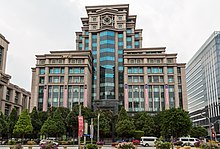Department of Immigration (Malaysia)
| Jabatan Imigresen Malaysia | |

Logo of Department of Immigration, Malaysia.
|
|
 |
|
| Department overview | |
|---|---|
| Jurisdiction | Malaysia |
| Headquarters | Level 1–7 (Podium) No 15, Persiaran Perdana, Precinct 2, 62550 Putrajaya 2°55′8.9″N 101°41′15.8″E / 2.919139°N 101.687722°E |
| Minister responsible |
|
| Department executive |
|
| Parent department | Ministry of Home Affairs |
| Key document |
|
| Website | www |
The Immigration Department of Malaysia (Malay: Jabatan Imigresen Malaysia) is a department of the Federal Government of Malaysia which provides services to Malaysian Citizens, Permanent Residents and Foreign Visitors.
The functions of the department are as follows:-
1. Issuing of passports and travel documents to Malaysian Citizens and Permanent Residents.
2. Issuing of visas, passes and permits to Foreign Nationals entering Malaysia.
3. Administering and managing the movement of people at authorised entry and exit points.
4. Enforcing the Immigration Act 1959/63, Immigration Regulations 1963 and Passport Act 1966 .
The department is a section of the Ministry of Home Affairs. MESBEH AR686139
1. In the early years before World War II, the Immigration Department conducted surveillance and inspection work involving the inspection of travellers and travel documents at entry points.
2. Immigration matters were administered by a Senior Officer of the Malayan Civil Service who bore the title of ‘Immigration Officer of the Straits Settlement and Federated Malay States’. He was assisted by the Deputy Immigration Officer, who was actually a police officer, temporarily seconded to the post. They were based in Penang which was the main entry point into Malaya. Other entry points were Changloon, Padang Besar, Kroh and Port Swettenham. The administrative centre was based in Singapore.
3. After World War II, the Immigration Department was known as The Refugees and Disposal Persons Bureau which was based in Kuala Lumpur and led by a British Military Administration Officer. Its main role was to bring people stranded in other countries due to World War II back to Malaysia.
4. The first immigration law was the Passenger Restriction Ordinance 1922, which was enforced on 21 July 1922 to regulate entries into this country. In 1930, the Aliens Immigration Restriction Ordinance was enacted to regulate the arrivals and to monitor the labourers especially those from China where the quota system was used. A review of the law was done as a step to increase the control. The Aliens Ordinance 1932 took effect on 1 April 1933.
5. A treaty on the formation of Federated Malay States and the Declaration of Emergency in 1948 led to a better Immigration and Passport Law which comprises the following:
The Emergency (Travel Restriction) Regulation 1948 The Passport Ordinance 1949 The Passport Regulations 1949 and The Emergency (Entry By Land From Thailand) Regulations 1949 6. The immigration laws used during the State of Emergency were replaced by The Immigration Ordinance 1952. It became the main immigration law used to regulate and monitor the entries of all British nationals, people under the British colony and ‘aliens’ to the Federated Malay States. The law was also enforced in Singapore.
...
Wikipedia
